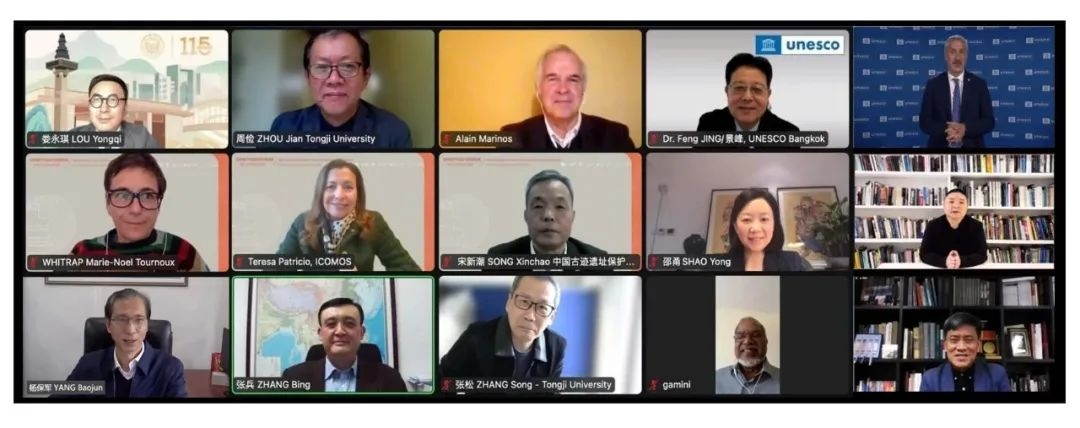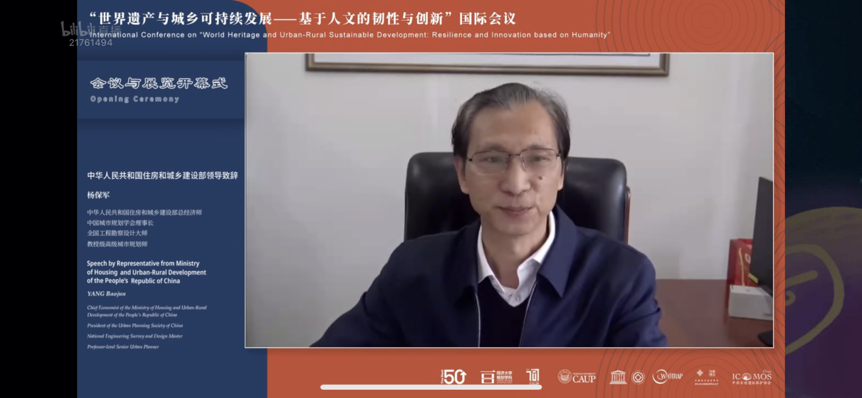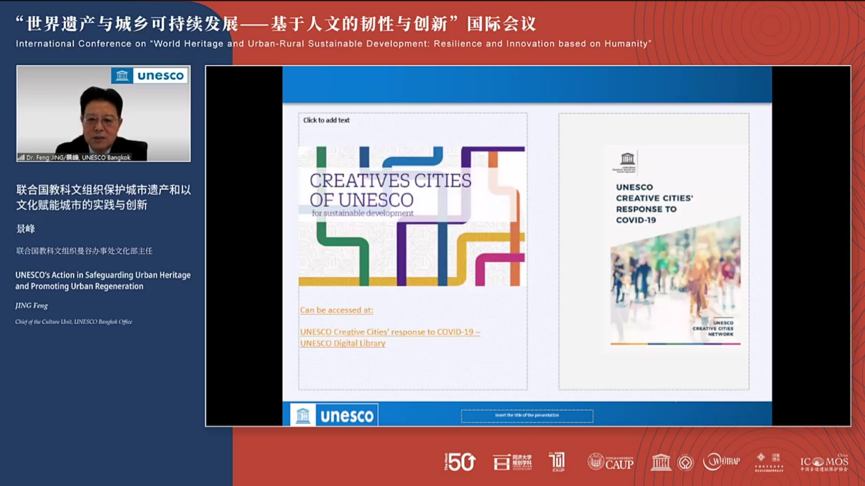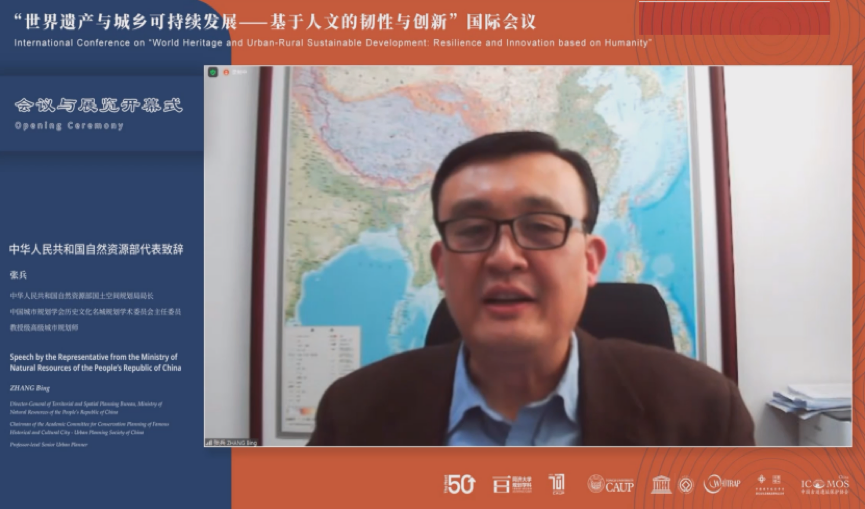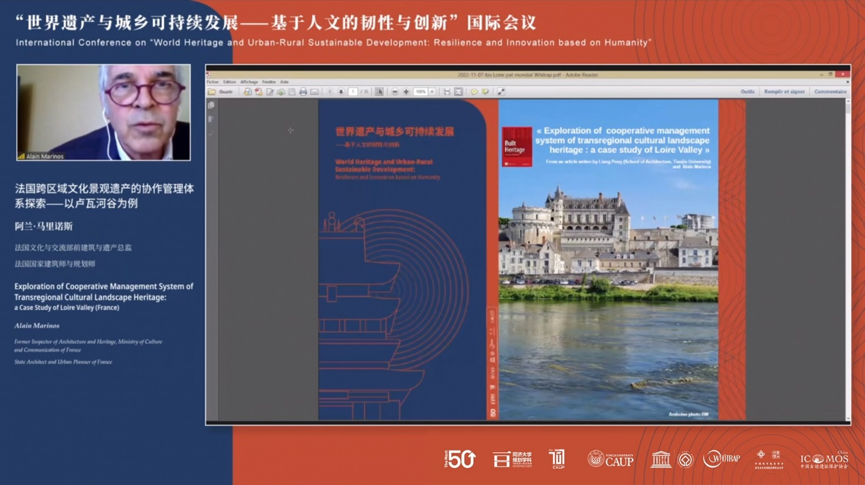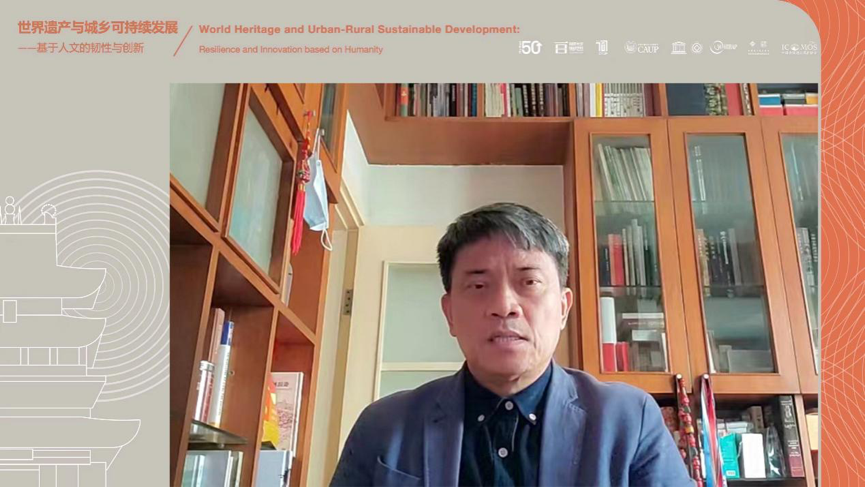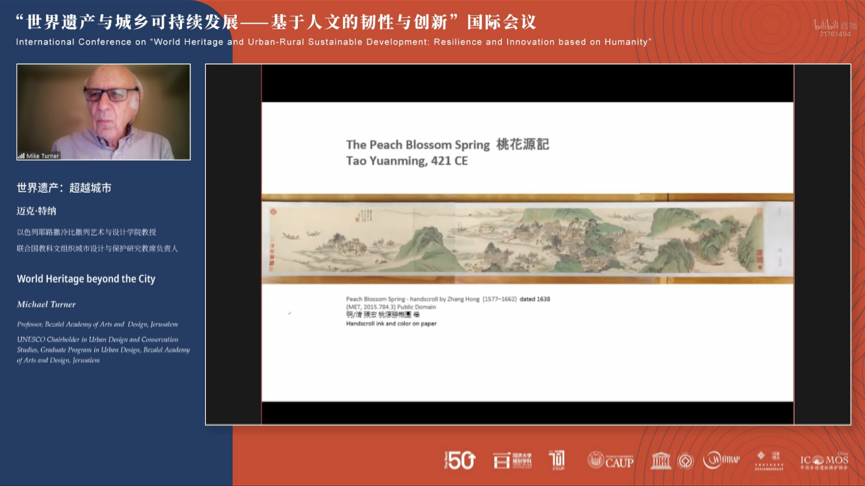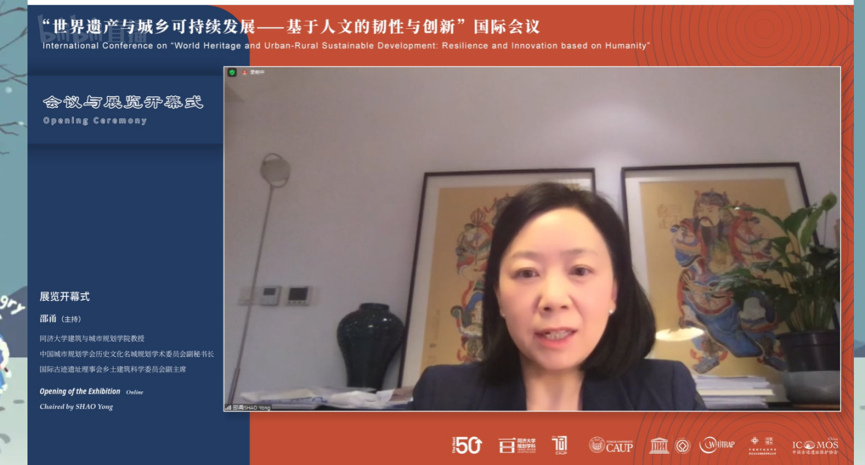| Highlights of Keynote Speeches at the Conference |
| PublishDate:2022-11-30 Hits:1656 |
The year 2022 marks both the 50th anniversary of the World Heritage Convention and the 40th anniversary of China’s National Famous Historical and Cultural Cities Protection System. The year is also the 70th anniversary of the College of Architecture and Urban Planning (CAUP) of Tongji University at Shanghai and the Tongji Planning Centennial, the 100th year since the university launched its first planning course. To join the world wide celebration for the World Heritage Convention's 50th anniversary focusing on “The next 50: World Heritage as a source of resilience, humanity and innovation”, on November 15th and 16th, CAUP of Tongji University, World Heritage Institute of Training and Research for the Asia and the Pacific Region(WHITRAP Shanghai) the Academic Committee for Conservation Planning of Famous Historical and Cultural City – Urban Planning Society of China, and ICOMOS China, successfully held an online international conference on “World Heritage and Urban-Rural Sustainable Development: Resilience and Innovation based on Humanity”, commemorating the 50th Anniversary of the World Heritage Convention, the 40thAnniversary of China’s National Famous Historical and Cultural Cities Protection System.
The conference is divided into four main parts: opening ceremony, keynote speeches, four thematic sub-forums and closing ceremony. In the keynote speeches session of the international conference, Yang Baojun, Chief Economist of the Ministry of Housing and Urban-Rural Development of the People’s Republic of China and President of the Urban Planning Society of China, Jing Feng, Chief of the Culture Unit, UNESCO Bangkok Office, Zhang Bing, Director-General of Territorial and Spatial Planning Bureau, Ministry of Natural Resources of the People’s Republic of China, Alain Marinos, Former Inspector of Architecture and Heritage, Ministry of Culture and Communication of France and State Architect and Urban Planner of France, Chang Qing, academician of Chinese Academy of Sciences and a professor of the College of Architecture and Urban Planning, Tongji University, Professor Michael Turner, the UNESCO Chairholder in Urban Design and Conservation Studies and a professor of Bezalel Academy of Arts and Design, Jerusalem, delivered keynote speeches.
The keynote speeches session was webcast on a number of online platforms, including CAUP.NET Channel, WUPENiCity Channel, CAUP of Tongji University Channel, Guihuayun Channel and Bilibili Website both in Chinese and English, with a total of over 13,000 viewers
Keynote Speeches
Forty Years of Conservation of Famous cities in China--Retrospect and Prospect YANG Baojun Chief Economist of the Ministry of Housing and Urban-Rural Development of People’s Republic of China President of the Urban Planning Society of China National Engineering Survey and Design Master Professor-level Senior Urban Planner
YANG Baojun, chief economist at the Ministry of Housing and Urban-Rural Development of the People’s Republic of China, reviewed the history and looked into the future of China`s national protection system of Famous Historical and Cultural Cities in the past 40 years in three parts: the "Historical Achievements", the "Dynamic Requirements of The Times" and" the Core Tasks of the Future".
Looking back on the past, since 1982, when The State Council announced the first batch of the national historical and cultural cities, remarkable achievements have been made in the protection of urban and rural historic and cultural heritage, and a protection system has been built up and gradually improved. With rapid urbanization, a large number of precious heritage properties have been protected, which have played an important role in urban and rural areas of extending the historical context, generating the cultural gene and shaping distinctive local features.
Faced with the current situation, he pointed out that we should fully adjust to the requirements of present time and take new responsibilities and actions under the new context. In the development of urban and rural areas, we should refer to the principles decided by the 20th National Congress of the CPC as our guidance, build upon the achievements made in the past 40 years of the Historical and Cultural Cities Protection System, and uphold the key message of the “Opinions on Strengthening the Protection and Inheritance of Historical and Cultural Heritage in Urban and rural Development” by the CPC Central Committee, so as to establish a protection and inheritance system characterized by scientific classification and effective protection and management, to promote the creative translation and development of traditional culture, and to infuse vitality, charm, and dynamism into historical and cultural heritage.
When addressing the path for the future, he stressed that we should focus on three core tasks. First, it is important to defend the protection as the bottom line of development and to cover comprehensive categories in a systematic way. Second, we should insist on protection through the use of heritage to give them new functions. Third, we need to improve institutional systems and mechanisms to enhance the management.
Finally, YANG Baojun concluded: "The historical and cultural heritage in urban and rural areas is witness to the brilliant history of a society. They contain the wisdom of running a country. These legacies have crossed time and space, connecting the ancient and modern worlds and informing us of the realm of 'heaven-man unity' and the diversity of cultures. To protect historical and cultural heritage is to protect the glory of the past, to cherish the treasures of today and to nurture the hope of the future."
UNESCO’s Action in Safeguarding Urban Heritage and Promoting Urban Regeneration JING Feng Chief of the Culture Unit, UNESCO Bangkok Office
Jing Feng first clarified the mission of UNESCO in the field of culture. UNESCO’s six culture conventions and the 2030 Agenda for Sustainable Development have provided a high-level guiding framework and cooperation opportunities for the protection of cultural diversity. Only by gaining a broad understanding of culture and the world's cultural heritage can we better bring economic and social benefits to the public and promote the development of the whole society. The core topic of MONDIACULT 2022,held in Mexico in September this year, is to formulate a global cultural policy roadmap. "The world gathers for culture". The Conference emphasized the role of culture in society and released the" Culture 2030" benchmark to measure the contribution of culture to environmental protection, education, gender equality and economic growth.
Then Jing Feng introduced the UNESCO cities' Platform, which focuses on the resource exchange and cooperation of urban networks at the regional level, and builds a sharing platform for best practice cases with the help of global experts. It is hoped that sustainable development goals can be better embedded in protection and planning, which will become a transformative force and create a resilient and inclusive social environment.
Jing Feng also shared a series of UNESCO actions and hot concepts in the field of culture and urban sustainable development. For example, creative city network, learning city, sustainable tourism, and UNESCO Asia-Pacific Awards for Cultural Heritage Conservation, etc. UNESCO Creative Cities Network (UCCN) was established in2004 to promote cooperation among cities that have identified creativity as a strategic factor for sustainable urban development. Almost 300 cities around the world have put culture and creativity at the heart of their sustainable urban development policies. Whether it be crafts and folk art, design, film, gastronomy, literature, music or media arts, Creative Cities are their innovative resources, knowledge and practices towards building more sustainable and better cities for all. From this perspective, the city is not only a carrier of cultural heritage, but also a carrier of human creativity and innovation ability.
A New Approach to Strengthening the Conservation and Management of the World Heritage Sites: The Practice of China’s Territorial Spatial Planning Reform ZHANG Bing Director-General of Territorial and Spatial Planning Bureau, Ministry of Natural Resources of the People’s Republic of China Chairman of the Academic Committee for Conservation Planning of Famous Historical and Cultural City - Urban Planning Society of China Professor-level Senior Urban Planner
Since the 18th National Congress of the CPC, China has comprehensively promoted the construction of ecological civilization, and the government has attached great importance to the protection of historical culture. President Xi Jinping has repeatedly given instructions to historical and cultural conservation, emphasizing that "historical culture is the soul of the city, and we must protect historical and cultural heritage in the way we value our own lives." In 2018, the State Council set up a new Ministry of Natural Resources to uniformly execute the control land and spatial use on abasis of application of digital and information technology, so as to form “one single map" for the national territorial spatial planning.
Zhang Bing pointed out that in recent years, China has actively improved its capacity for sustainable development, implemented the 2030 Agenda for Sustainable Development, and improved heritage protection measures in multiple scales and dimensions in the context of land and spatial planning reform. The territorial spatial planning aims to collect and aggregate all the information regarding spatial protection and utilization of cultural heritage into "one map", so that cultural heritage protection runs through the whole process of territorial spatial development, utilization, and construction, and at the same time to build a dynamic monitoring and early warning system for cultural heritage.
Finally, Zhang Bing explained the important role of the territorial spatial planning in the protection of cultural and natural heritage by giving an innovative protection case of the World Heritage Mogao Caves and Mingsha Crescent Spring Scenic Area in Dunhuang City.
Exploration of Cooperative Management System of Transregional Cultural Landscape Heritage: A Case Study of Loire Valley (France) Alain Marinos Former Inspector of Architecture and Heritage, Ministry of Culture and Communication of France State Architect and Urban Planner of France
Alain Marinos started his presentation with an overview of the World Heritage site the Loire Valley, and its outstanding universal values, and introduced in particular the heritage conservation and management of the property since 2002. MVL (The Val de Loire Mission), an inter-regional cooperative management system funded by the governments of the two regions straddled by the Loire Valley, was established to coordinate local authorities and relevant stakeholders. The establishment of the cooperative system helped to consider management programs and actions in the Loire Valley within the public policy priorities of both regions. Public meetings are also organized for reflection and discussion among planning professionals, local associations, residents, teachers, researchers and other members, and an action plan is developed each year based on the content of these meetings.
Alain Marinos also introduced some practical projects of the Loire Valley, including the well-known riverside bike routes and the customary boat-making events held during the appropriate festivals, etc. The Loire Valley has become an important local identity, with the widespread use of the Loire Valley emblem by enterprises and other commercial entities, and was emerging as a significant symbol of the harmonious coexistence between human life and landscape.
In the end, Alain Marinos concluded that going beyond the simple actions of heritage conservation in most heritage sites, the conservation experience of the Loire Valley has introduced innovative ideas aimed at revealing the significance and cultural values of the territories, which is still worth learning today from the perspective of sustainable development.
Coexistence of the Old and the New: Exploration of the Regeneration Design of the Haikou Qilou Historic District CHANG Qing Academician of Chinese Academy of Sciences Professor, College of Architecture and Urban Planning, Tongji University
The presentation gave a detailed summary of the past and future of a regeneration project of Haikou Qilou Historic District, including the background, the conservation and renovation process and the revitalization and reuse of the properties. The speech elaborated on the history, protection and restoration, regeneration design and implementation processes, focusing on the design and implementation of the arcade building and corridors, the internal regeneration design mode of the arcade, the space improvement and scene reconstruction of the street temple - Tianhou Palace, and the regeneration of the former site of Qiong Customs, creative design for the coexistence of old and new on the Long Causeway Road of the Outer Beach. Contributing to the current theoretical debate at the international frontiers, the speech explores a variety of concepts such as "restoration to its recent state", " renovation to its original state" and "coexistence of the new and the old", as well as their application in the renovation and regeneration of the old blocks of Haikou Arcade Bund. Finally, an animated video was played to showcase the vision of a comprehensive revival of Haikou Arcade Bund Historic and Cultural District.
World Heritage beyond the City Michael Turner Professor, Bezalel Academy of Arts and Design, Jerusalem UNESCO Chairholder in Urban Design and Conservation Studies, Graduate Program in Urban Design, Bezalel Academy of Arts and Design, Jerusalem
Mr. Michael Turner 's speech started from "The Peach Blossom Spring", using literary works to elicit utopian imagination. Based on the harmonious coexistence of human and nature, he recalled the implications of "Garden City Theory" and the evolution of the concept of "Sustainable Development Theory" as well as its concern for cultural factors and human well-being. Then he discussed the problems of environmental pollution, urban fragmentation, and urban-rural separation in the process of rapid urban development and metropolitanization. He emphasized the understanding and strengthening of the resilience of heritage conservation and management based on space-time view, beyond the historic center, thereby enhancing the cohesion and continuity of cities. In short, this speech dialectically discussed the relationship between the urban and rural areas, culture and nature, the material and spiritual, and heritage and human being achieved through Heritopolis – Heritage and the Metropolis.
Summary of the Presentations
Finally, Professor Shao Yong made a summary of the presentations. She pointed out that the keynote session aimed to provide a glimpse of the challenges facing the current metropolis from not only the perspectives of the historic urban landscape but also from the temporal and spatial dimensions. To deal with various relationships mentioned in the keynote session, especially the relationship between urban and rural areas, culture and nature, tangible and intangible, people and nature, heritage and people, etc., is particularly important in the exploration of the sustainable development path of the current metropolis. This keynote session provided a new direction for HUL for the next decade.
Shao Yong expressed her gratitude to the six speakers for sharing their points on the World Heritage and sustainable urban and rural development from different spatial scales and perspectives, and also expressed her wish to continue international cooperation to protect the common heritage of human beings.
Edited by CUI Jiangying, LI Xintian, PAN Yanhan Collected by YANG Wenjun, WU Yujie, GENG Qianzheng, CAI Xi, LI Shuyin, LIN Feifei Typest by ZHANG Yuzhuo (Intern), JI Zhenjiang (Intern)
|
- News | WHITRAP Shanghai and CNR-ISPC bilateral meeting
- News | WHITRAP meets Cité de l’Architecture et du Patrimoine
- WHITRAP Hosting "Workshop on Preliminary Assessment for National Focal Points of the Asia Region" in Chengdu
- WHITRAP Shanghai meets UNESCO
- INTERNATIONAL CONFERENCE PRELIMINARY ANNOUNCEMENT & CALL FOR PAPERS
- Observation of the 46th Session of the World Heritage Committee
Copyright © 2009-2012 World Heritage Institute of Training and Research-Asia and Pacific (shanghai)


